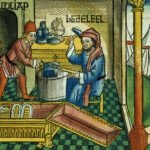The Christmas Metanarrative
As it happens, I am just finishing up reading the book of Revelation as part of my daily reading. So in a few days it will be back to Genesis. As I have often stated, if you simply read around 3 chapters of the Bible a day, you will get through the whole book in a year.
Of course that is a minimum – one can and should read more. And it is not just about speed-reading either. Real study, contemplation and prayerful interaction with Scripture are obviously vital. But one has to at least read it before one can ruminate over it.
So if this is not yet your regular practice, then why not make it a New Year’s resolution? The Christian story, and the Christmas story in particular, make no sense without getting the whole picture. And that is why we have the 66 books of the Bible to give us that big picture, the metanarrative.
Now if you know anything about one recent intellectual trend – postmodernism – you will know that these folks have a disdain for metanarratives. They claim there is no such thing. There is no grand, overarching story that ties everything together and explains all the details of life. They claim we only have our own personal stories, and that is it.
They could not be more wrong, biblically speaking. The Bible gives us an amazing, sweeping metanarrative. Indeed, it is the story. Christians sometimes say that history is really His Story – and they are quite right. All of human history centres on the life, death and resurrection of Jesus Christ.
So Christmas is the story of the incarnation, of God becoming flesh. It is about God entering human history to deal with mankind’s greatest need: sin and selfishness. Thus it is an absolutely integral part of the biblical metanarrative. But instead of dealing with philosophy or lofty theology, let me seek to explain this metanarrative in very simple layman’s terms.
The gospel message is really nothing other than an old fashioned love story. It is your typical three-part love story. Any good dime-store romance novel worth its salt will always have these three elements:
-boy meet girl
-boy loses girl
-boy woos and wins back girl
Tying this into the biblical account is quite easy. The opening chapters of Genesis on creation of course give us part one of this meta-drama. The fall, which takes place very early on in the biblical account, is part two. And basically the rest of the biblical metanarrative, culminating in the gospel accounts of the incarnation, life, death, and resurrection of Jesus, comprises part three.
And of course any good love story has to have a wedding at the end. And this morning I once again read that very thing in Rev. 19:6-9:
Then I heard what sounded like a great multitude, like the roar of rushing waters and like loud peals of thunder, shouting:
“Hallelujah!
For our Lord God Almighty reigns.
Let us rejoice and be glad
and give him glory!
For the wedding of the Lamb has come,
and his bride has made herself ready.
Fine linen, bright and clean,
was given her to wear.”
(Fine linen stands for the righteous acts of God’s holy people.)
Then the angel said to me, “Write this: Blessed are those who are invited to the wedding supper of the Lamb!” And he added, “These are the true words of God.”
So the grand climax of human history is a glorious wedding. All the people of God collectively will join in the greatest wedding of all time, as she joins fully with Christ when he returns. That is where human history is heading, and that is why Jesus Christ was born.
He did not come to earth merely to be some sort of good example to us. He did not come offering mere moral platitudes. He did not come to tell us how wonderful we all are. No, he came to die. He came to pay the price for our horrific sin, in the hope that some would respond, repent, and enjoy the forgiveness of sin and a new life in Christ.
Yes, Christ was born to die. That is why he came here. He left the comforts and loving environment of heaven to come to a sin-soaked and hellish planet earth to set us free from sin and self. As C. S. Lewis put it in Mere Christianity, “The central miracle asserted by Christians is the Incarnation. . . . If the thing happened, it was the central event in the history of the earth.”
Moreover, “This universe is at war. It is a civil war, a rebellion, and … we are living in a part of the universe occupied by the rebel. Enemy-occupied territory – that is what this world is. Christianity is the story of how the rightful king has landed, you might say landed in disguise, and is calling us all to take part in a great campaign of sabotage. When you go to church you are really listening-in to the secret wireless from our friends: that is why the enemy is so anxious to prevent us from going.”
And again, “Fallen man is not simply an imperfect creature who needs improvement: he is a rebel who must lay down his arms.” Boy loved girl but boy lost girl. So he spent the rest of the time wooing back the girl. Even though the girl resisted and thwarted that wooing, in the end his love broke through.
Tragically of course not everyone responds to that wooing. Many remain in their rebellion and continue to shake their fists at God and his Son. They want nothing to do with his grand offer of love and forgiveness. And God of course is too much of a gentleman to force any rebellious sinner to choose him. Sadly, therefore, many do not.
But if you want to know the reason for Christmas, this love story is it. And God pleads with us to become part of that great love story. The choice is ours, but Christ has done everything to win us back to him. We only have one life to get it right. My prayer is that we all will.
In closing, some parts of several sermons by Augustine of the fourth century provide a worthy way to end this piece:
“He was created of a mother whom He created. He was carried by hands that He formed. He cried in the manger in wordless infancy. He, the Word, without whom all human eloquence is mute.” Augustine, Sermon 188 2,2
“He lies in a manger, but contains the world. He feeds at the breast, but also feeds the angels. He is wrapped in swaddling clothes, but vests us with immortality. He found no place in the inn, but makes for Himself a temple in the hearts of believers. In order that weakness might become strong, strength became weak.” St. Augustine, Sermon 190 3,4
“Maker of the sun, He is made under the sun. In the Father He remains, from His mother He goes forth. Creator of heaven and earth, He was born on earth under heaven. Unspeakably wise, He is wisely speechless. Filling the world, He lies in a manger. Ruler of the stars, He nurses at His mother’s bosom. He is both great in the nature of God, and small in the form of a servant.” Augustine, Sermon 187
[1240 words]




















Thanks Bill. This is a beautifully written and timely article.
Will Taylor
“-boy woos and wins back girl”
Err, how about
“-boy battles impossible odds, overcomes apparent loss of girl’s love, eventually woos and wins back girl”
🙂
John Angelico
The secularist, Darwinists, humanists, atheists and all the other idolaters have a metanarrative which is called evolution, which when spelt out is horrible; it’s just that folks never hear it preached; instead we breath it through the mass media like black atomic dust, without being any the wiser. It is about time we unpacked their narrative and put it on display.
David Skinner, UK
Speaking of postmodernism: Michael Cassidy was on the radio tonight talking about truth. He pointed out that nowadays we can hear our contemporaries say that a thesis and its antithesis can both be true e.g. if you believe that Jesus was crucified and I believe he wasn’t, we can both be right. It all depends on what’s ‘true for you’. Whew… whatever happened to thinking?
Terry Darmody
Those words of Augustine are beautiful!
Thank-you Bill! Hope you have a very happy and blessed Christmas, as you deserve! Praying for your family! May God bless you and your work in 2013.
Jane Byrne